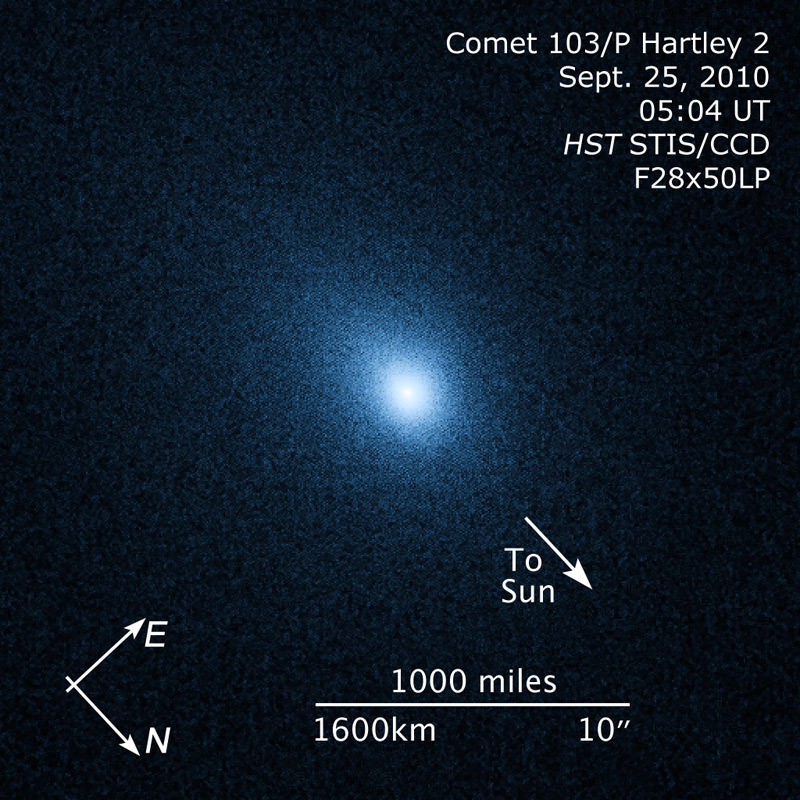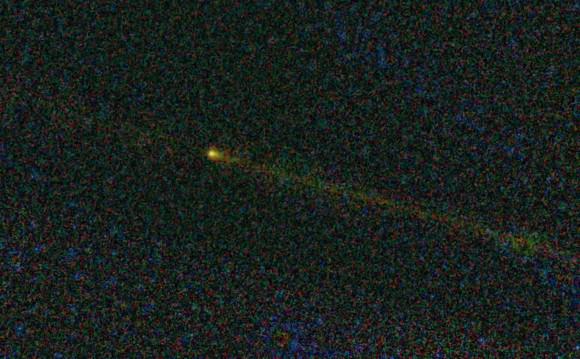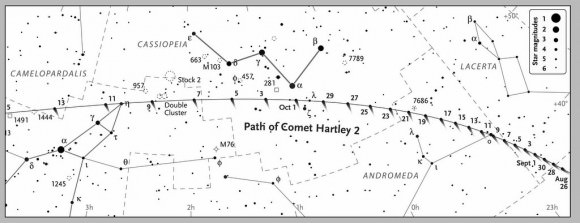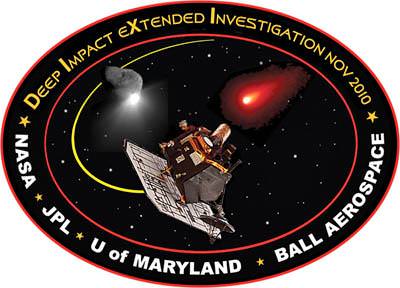Watch live coverage of the EPOXI mission’s close flyby of Comet Hartley 2. Live coverage begins on November 4, 2010 at 9:30 a.m. EDT (6:30 a.m. PDT) from mission control at the Jet Propulsion Laboratory. You can watch NASA TV’s Media Channel online at this link, (and make sure you click on the “Media Channel” tab on the right side of the “tv” screen). You can also watch on JPL’s UStream channel online. Coverage includes closest approach, an educational segment, and the return of close-approach images. Emily Lakdawalla of the Planetary Society Blog has posted a very detailed timeline of the encounter.
Continue reading “Watch Live Coverage of EPOXI’s Hartley 2 Encounter on Nov. 4”
Comet Hartley 2 Scouted by WISE, Hubble for Upcoming Encounter

[/caption]
In a little less than a month, NASA’s Deep Impact spacecraft (its current mission is called EPOXI) will fly by the comet Hartley 2 to image the comet’s nucleus and take other measurements. In preparation for this event, both the Wide-field Infrared Survey Explorer (WISE) and the Hubble Space Telescope have imaged the comet, scouting out the destination for Deep Impact.
On November 4th of this year, Deep Impact will come within 435 miles (700 km) of the comet Hartley 2, close enough to take images of the comet’s nucleus.
The name of the mission is EPOXI, which is a combination of the names for the two separate missions the spacecraft has been most recently tasked with: the extrasolar planet observations, called Extrasolar Planet Observations and Characterization (EPOCh), and the flyby of comet Hartley 2, called the Deep Impact Extended Investigation (DIXI). The spacecraft itself is still referred to as Deep Impact, though, despite the changes and extensions of its mission.
NASA’s Deep Impact mission to slam a copper weight into comet Tempel 1 was a wonderful success, sending back data that greatly improved our understanding of the composition of comets. After the encounter, though, there was still a lot of life left in the spacecraft, so it was tasked with another cometary confrontation: take images of the comet Hartley 2.
Deep Impact is an example of NASA using a single spacecraft to perform multiple, disparate missions. In addition to impacting and imaging Tempel 1 and performing a flyby of Hartley 2, the spacecraft took observations of 5 different stars outside of our Solar System during the period between January and August of 2008 (8 were scheduled, but some observations were missed due to technical difficulties).
It looked at stars with known exoplanets to observe transits of those planets in front of the star, giving astronomers a better idea of the orbital period, albedo – or reflectivity – and size of the planets.
Click here for a list of the various stars and transits it observed, as listed on the mission page.
Deep Impact also took data on both the Earth and Mars as they passed in front of our own Sun, to help characterize what exoplanets with a similar size and composition the Earth and Mars would look like passing in front of a star.

As of September 29th, Deep Impact was about 23 million miles (37 million km) away from Hartley 2. It is approaching at roughly 607,000 miles a day (976,000 km), so that puts it at about 18 million miles (29 million km) away from the comet today. As it approaches, Deep Impact will speed up, to over 620,000 miles (1,000,000 km) per day.

You won’t have to depend on NASA’s observatories and the spacecraft to see a view of Hartley 2, though – you should be able to see it with the naked eye or binoculars near the constellation Perseus throughout the month of October. On October 20th, it will make its closest approach to Earth at a distance of 11 million miles (17.7 million km). The comet is officially designated 103P Hartley, and for viewing information you can go to Heavens Above.
As always, check this space regularly for updates on the upcoming flyby.
Sources: JPL here, here and here, Hubblesite, Heavens Above
Spacecraft to Make Final Flyby of Earth
[/caption]
The re-purposed Deep Impact spacecraft will make one final flyby of Earth on Sunday June 27, 2010, getting a gravity assist to help propel the spacecraft towards a meetup with comet Hartley 2 this fall. The spacecraft bus that brought the Deep Impact “impactor” to comet Tempel 1 in July of 2005 has been put back to work double time where two new missions share the same spacecraft. This is the fifth time this spacecraft has flown by Earth, and at the time of closest approach on Sunday, it will be about 30,400 kilometers (18,900 miles) above the South Atlantic.
“The speed and orbital track of the spacecraft can be changed by changing aspects of its flyby of Earth, such as how close it comes to the planet,” said University of Maryland astronomer Michael A’Hearn, principal investigator for both the new EPOXI mission and its predecessor mission, Deep Impact.
The combined operation EPOXI is a combo-acronym of the two separate missions. The Deep Impact Extended Investigation (DIXI) of comets will observe comet 103P/Hartley 2 during a close flyby in November 2010. The other half of the dynamic duo, called the Extrasolar Planet Observation and Characterization (EPOCh) which is observing stars already known to have transiting giant planets.
“There is always some gravity boost at a flyby and in some cases, like this one, it is the main reason for a flyby. The last Earth flyby was used primarily to change the tilt of the spacecraft’s orbit to match that of comet Hartley 2, and we are using Sunday’s flyby to also change the shape of the orbit to get us to the comet,” said A’Hearn.
The Deep Impact mission smashed a companion probe into comet Tempel 1 on July 4, 2005 to reveal the inner material of a comet.
“Earth is a great place to pick up orbital velocity,” said Tim Larson, the EPOXI project manager from NASA’s Jet Propulsion Laboratory in Pasadena, Calif. “This flyby will give our spacecraft a 1.5-kilometer-per-second [3,470 mph] boost, setting us up to get up close and personal with comet Hartley 2.”
During a previous flyby of Earth, the mission team has used the spacecraft’s instruments to find evidence of water on the Moon and to study light reflected from Earth as a template that scientists eventually may be able be use to identify Earth-like planets around other stars.
Source: University of Maryland
Deep Impact
[/caption]
Deep Impact is the name of a NASA space mission whose primary objective was to study Comet Tempel 1 (a.k.a. 9P/Tempel). It was launched on 12 January, 2005, and the smart impactor crashed into the comet on 4 July, 2005.
Oh, and yes, Deep Impact is also the name of a movie … but the two have no connection (the science team came up with their name independently of the Hollywood studio), other than that they both concern a comet!
Comets had been the focus of several space probes before Deep Impact, perhaps the most famous of which is the ESA’s Giotto flyby of Comet Halley. However, flybys could not, and cannot, tell us much about what’s beneath the cometary surface; in particular, what the relative amounts of ices and dust is, how porous the comet body is, and so on. The Deep Impact mission was designed to address many of these unknowns.
The space probe consisted of two parts, a 370 kg copper Smart Impactor – that smashed into the comet – and the Flyby section, which watched the impact from a safe distance. In addition, many ground-based telescopes – including those of thousands of amateurs – and some space-based ones, watched the event from an even safer distance.
The mission was a great success in that the heavy copper section did, in fact, smash into the comet, and the other section did observe the impact up-close-and-personal, but safely. A great deal was learned about this comet – its composition and mechanical strength, etc – and comets in general. However, the plume which resulted from the impact was much denser than expected, so the Flyby did not get any images of the impact crater itself.
After the encounter with Comet Tempel 1, an extended mission for the Flyby was designed and implemented, called EPOXI, after its two objectives: the Extrasolar Planet Observation and Characterization (EPOCh) and the Deep Impact Extended Investigation (DIXI) … hence Extrasolar Planet Observation and Deep Impact Extended Investigation. The former uses the larger telescope on the space probe to look for exoplanet transits; the latter is a flyby of another comet, Hartley 2, now expected on 11 October, 2010.
There are several official Deep Impact websites, including NASA’s, JPL’s (Jet Propulsion Laboratory), and the University of Maryland’s on EPOXI.
The Deep Impact mission resulted in lots of Universe Today stories, far too many to mention here. Some of the best are Deep Impact Smashes into Temple 1, What the Ground Telescopes Saw During Deep Impact, Deep Impact Turns Up Cometary Ice, and Deep Impact Begins Searching for Extrasolar Planets.
Comets, our Icy Friends from the Outer Solar System is a good Astronomy Cast episode which gives a good background on comets.
Source: NASA


